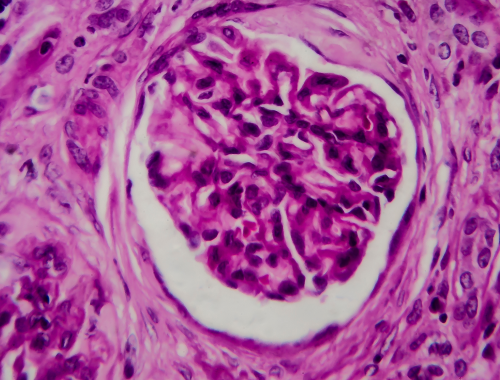Difference Between Chronic Glomerulonephritis and Chronic Interstitial Nephritis
Chronic glomerulonephritis is the long-term inflammation of the glomeruli of the kidneys. Glomerulus is the renal unit which is specialized in filtering blood. Chronic interstitial nephritis is a disorder in which the renal interstitium becomes inflamed or swollen. It spares the glomerulus.

What is chronic glomerulonephritis?
Definition:
Chronic glomerulonephritis is the long-term inflammation of the glomeruli of the kidneys.
Causes:
The condition is seen in several infections such as post-streptococcal glomerulonephritis, HIV, and viral infections. It is associated with autoimmune diseases like rheumatoid arthritis, lupus, Goodpasture’s syndrome, vasculitis, and IgA nephropathy. Diabetes can also cause chronic glomerulonephritis.
Symptoms:
The symptoms of glomerulonephritis include hematuria, frothy urine, periorbital swelling, ankle edema, generalized body swelling, blood in the stools, groin or abdominal pain, and oliguria. The patient experiences fatigue and generalized muscle pain.
Diagnosis:
Initial tests for diagnosing chronic glomerulonephritis include urine dipstick and culture, blood tests, and imaging studies such as X-ray, ultrasound, and CT scan. Kidney biopsy, however, is the gold standard test for diagnosing glomerulonephritis.
Treatment:
Dietary changes such as reduced protein and salt intake are incorporated in glomerulonephritis patients. Primarily immunosuppressants are given to reduce inflammation; these include steroids, cyclophosphamide, mycophenolate mofetil, azathioprine, ciclosporin, and tacrolimus. Blood pressure is controlled via angiotensin-converting enzyme (ACE) inhibitors, and angiotensin receptor blockers (ARB). Statins are prescribed for normalizing high cholesterol. If medical therapy fails, a renal transplant may be needed.

What is chronic interstitial nephritis?
Definition:
Chronic interstitial nephritis is a disorder in which the renal interstitium becomes inflamed or swollen. It spares the glomerulus.
Causes:
Chronic interstitial nephritis is seen in autoimmune diseases such as lupus and sarcoidosis, in hypokalemia and hypocalcemia, with aggressive use of certain medications, and in some infections.
Symptoms:
Symptoms of chronic interstitial nephritis include blood in the urine, lethargy, fever, altered level of consciousness, confusion, weight gain, nausea vomiting, generalized body swelling, and oliguria.
Diagnosis:
Chronic interstitial nephritis is diagnosed through physical examination, blood pressure monitoring, urine tests, blood tests, and renal biopsy.
Treatment:
Chronic interstitial nephritis is treated with medicines like antihypertensives, anti-inflammatory drugs, and immunosuppressants. Furthermore, dialysis or kidney transplants may be needed in the long run.
Difference Between Chronic Glomerulonephritis and Chronic Interstitial Nephritis
Definition:
Chronic glomerulonephritis is the long-term inflammation of the glomeruli of the kidneys. Glomerulus is the renal unit which is specialized in filtering blood. Chronic interstitial nephritis is a disorder in which the renal interstitium becomes inflamed or swollen. It spares the glomerulus.
Causes:
Chronic glomerulonephritis is seen in several infections such as post-streptococcal glomerulonephritis, HIV, and viral infections. It is associated with autoimmune diseases like rheumatoid arthritis, lupus, Goodpasture’s syndrome, vasculitis, and IgA nephropathy. Diabetes can also cause chronic glomerulonephritis. Chronic interstitial nephritis is seen in autoimmune diseases such as lupus and sarcoidosis, in hypokalemia and hypocalcemia, with aggressive use of certain medications, and in some infections.
Symptoms:
The symptoms of glomerulonephritis include hematuria, frothy urine, periorbital swelling, ankle edema, generalized body swelling, blood in the stools, groin or abdominal pain, and oliguria. The patient experiences fatigue and generalized muscle pain. Symptoms of chronic interstitial nephritis include blood in the urine, lethargy, fever, altered level of consciousness, confusion, weight gain, nausea vomiting, generalized body swelling, and oliguria.
Diagnosis:
Initial tests for diagnosing chronic glomerulonephritis include urine dipstick and culture, blood tests, and imaging studies such as X-ray, ultrasound, and CT scan. Kidney biopsy, however, is the gold standard test for diagnosing glomerulonephritis. Chronic interstitial nephritis is diagnosed through physical examination, blood pressure monitoring, urine tests, blood tests, and renal biopsy.
Treatment:
Dietary changes such as reduced protein and salt intake are incorporated in glomerulonephritis patients. Primarily immunosuppressants are given to reduce inflammation; these include steroids, cyclophosphamide, mycophenolate mofetil, azathioprine, ciclosporin, and tacrolimus. Blood pressure is controlled via ACE inhibitors, and ARBs. Statins are prescribed for normalizing high cholesterol. If medical therapy fails, a renal transplant may be needed. Chronic interstitial nephritis is treated with medicines like antihypertensives, anti-inflammatory drugs, and immunosuppressants. Furthermore, dialysis or kidney transplants may be needed in the long run.
Table of differences between Chronic Glomerulonephritis and Chronic Interstitial Nephritis

FAQs
What is the difference between glomerulonephritis and nephrotic syndrome?
Glomerulonephritis is the inflammation of the glomeruli of the kidney. Nephrotic syndrome is associated with much more significant proteinuria than glomerulonephritis.
Are nephritis and glomerulonephritis the same?
Yes.
What is the other name for chronic interstitial nephritis?
Chronic tubulointerstitial nephritis.
What is chronic interstitial nephritis?
Chronic interstitial nephritis is a disorder in which the renal interstitium becomes inflamed or swollen. It spares the glomerulus.
What are the two types of glomerulonephritis?
Is chronic glomerulonephritis nephritic or nephrotic?
It can present as nephritic syndrome, nephrotic syndrome, or both.
What is the most common cause of interstitial nephritis?
Medications such as analgesics.
How is chronic interstitial nephritis diagnosed?
Chronic interstitial nephritis is diagnosed through physical examination, blood pressure monitoring, urine tests, blood tests, and renal biopsy.
What is the triad of interstitial nephritis?
Fever, rash, and eosinophilia.
- Differences Between Reptiles and Amphibians - May 17, 2024
- Difference Between Ophthalmology and Optometry - May 15, 2024
- Difference Between Fear and Anxiety - April 2, 2024
Search DifferenceBetween.net :
Leave a Response
References :
[0]Ihm, Chun-Gyoo. "Hypertension in chronic glomerulonephritis." Electrolytes & Blood Pressure: E & BP 13.2 (2015): 41.
[1]Ihm, Chun-Gyoo. "Hypertension in chronic glomerulonephritis." Electrolytes & Blood Pressure: E & BP 13.2 (2015): 41.
[2]Kawasaki, Yukihiko. "Mechanism of onset and exacerbation of chronic glomerulonephritis and its treatment." Pediatrics International 53.6 (2011): 795-806.
[3]Murray, T. M., and M. Goldberg. "Chronic interstitial nephritis: etiologic factors." Annals of internal medicine 82.4 (1975): 453-459.
